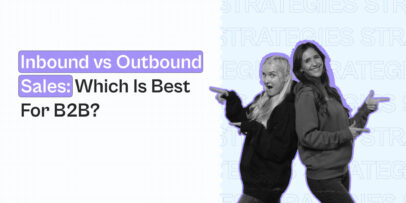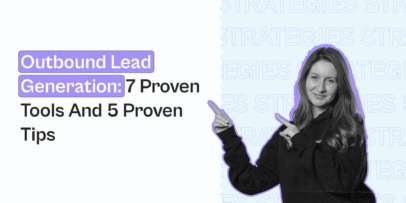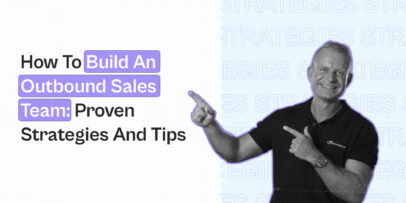What Is the Difference Between an Ideal Customer Profile vs Buyer Persona?
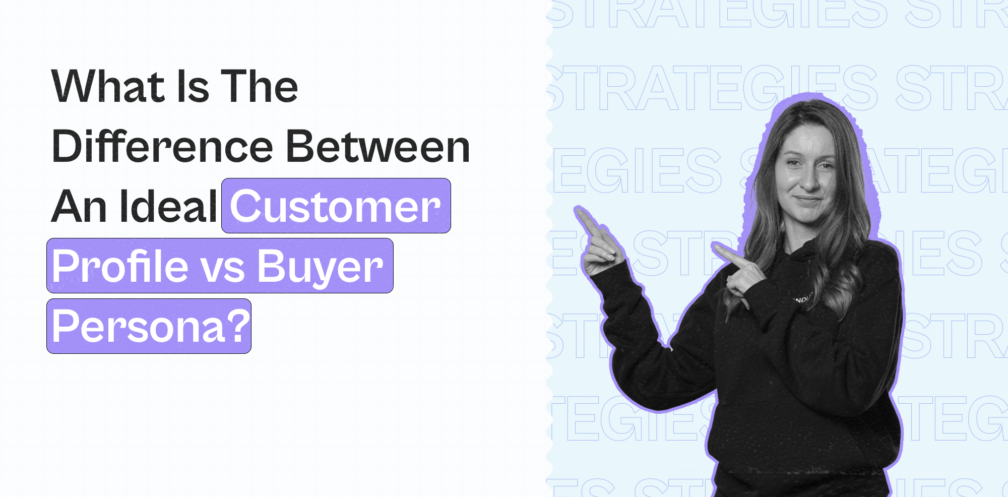
The first step in your marketing and sales strategy is defining who you want to work with and differentiating the ideal customer profile vs buyer persona.
You have probably heard different terms that all have a similar meaning. Some marketing experts call them buyer personas, others define them as customer avatars, while some use the term ideal customer profile (ICP).
Is there any difference? After reading this article, you’ll better understand these terms, their similarities and their differences. You will also learn the difference between an ideal customer profile and a buyer persona.
Here’s what we’re going to talk about:
- Explanation of the Terms – What Is ICP and Buyer Personas
- What Are the Similarities Between ICP and Buyer Persona?
- What Differs an Ideal Customer Profile From a Buyer Persona?
- How Do ICP and Buyer Personas Influence a Successful Outreach
- The Step-by-step Process of Creating an Ideal Customer Profile and Buyer Personas
- How to Fit ICP and Buyer Personas Into Your Lead Generation Strategy

But before we get started…
Do you know about the newest sales tactics and proven outreach campaigns from our private LinkedIn Outreach Family Facebook group? If not yet – join now and say hello!
Now let’s go ahead with the ICPs and buyer personas!
Explanation of ICP and Buyer Personas
ICP and Buyer Persona are among the most important documents every business should create in order to optimize sales and marketing efforts and reach its target audience. They represent the characteristics of your ideal customer.
Although they are two different documents, they have many things in common and their goals are similar.
Now, you may be wondering whether you need both of them in your business. Everything depends on your industry and the size of your business, but many successful companies have both ICP and buyer personas simultaneously.
What Makes ICP and Buyer Persona Similar?
It’s no wonder that many people confuse these two terms: in some situations, they can be used interchangeably. Here are some characteristics that ICP and Buyer persona have in common:
- They have a similar purpose. Both help companies understand who they are selling to, which leads to optimizing their marketing and sales strategy.
- They are often used simultaneously. Both can be used in all stages of the sales pipeline and customer journey.
- They help your team stay focused on the customer and their needs.
Finally, these terms aren’t reserved only for your marketing and sales teams. Understanding your customer profiles and buyer personas is essential for improving your product and providing excellent customer support.
What Is the Difference Between an Ideal Customer Profile and a Buyer Persona?
We’ve covered their similarities, but now we’ll discuss the critical differences between these two terms.
The main difference between the two terms is that the ideal customer profile is used to describe a type of company that would be your ideal customer. Buyer personas stand for different people that buy from you.
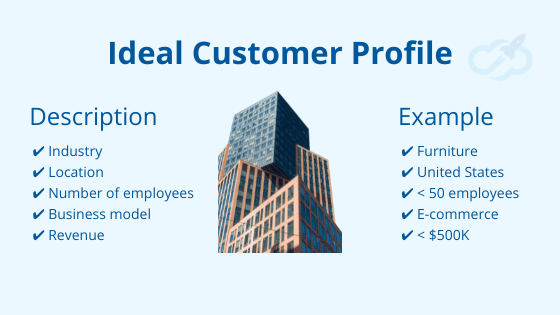
Ideal customer profile definition
ICP is a fictitious description of an ideal company with all characteristics of your perfect customer. They are a perfect fit for the products and services that your company provides.
ICP provides guidelines that can help you understand whether a customer is a good fit for your company or not. This allows your sales reps to save time and focus only on your best customers.
- ICP is used mainly by B2B companies.
- ICP is created using statistical data from CRM, analytics tools and by interviewing your best customers.

Buyer personas definition
A buyer persona (or customer avatars) is a semi-fictional representation of your customers. It helps you identify individuals with different job roles and decision-makers behind every purchase.
It offers an in-depth understanding of the goals and motivations that drive your existing customers and the challenges they’re facing. That said, understanding different buyer personas can help you improve how you communicate with leads.
- Buyer personas are used both in B2B and B2C companies.
- They tend to focus more on the individuals and decision-makers than on companies.
- Buyer personas are based on data about your current customers. They can be created using customer interviews, sales team interviews, and demographic data from tools like Google Analytics.
- While most companies have 3-6 ICPs, they usually have multiple buyer personas for each ICP as well. According to the Pragmatic Institute, an average ICP has 3-5 buyer personas.
In other words, many businesses use ICP at the beginning of the sales process to help them target ideal companies with the desired characteristics. However, when it’s time to close the sale and you are dealing with actual people who work in that company, knowing your buyer personas can help you understand them and close a contract.
The Importance of ICP and Buyer Personas for a Successful Outreach
Having these documents as guidelines will help you identify the right prospects, which will make your outreach strategy more successful. Here are five reasons why you should create ICP and buyer persona before the outreach:
Focus
During the prospecting stage, ICP allows your outbound sales team to focus only on high-quality prospects instead of trying to pursue the entire market segment.
High focus saves time and effort and allows them to spot the right opportunities that otherwise might go unnoticed. As a result, your business gets prospects with higher deal value and revenue quota.
Personalization
Personalization is one of the most crucial aspects of outreach campaigns. It shows that you’ve spent time researching the company and its pain points, making them much more likely to do business with you. By personalizing your cold outreach message to a specific audience’s needs or pains you’ll be able to get more leads
Personalization can also increase your email open rate by 29% and LinkedIn connection rate by 74%.
Check out our Expandi + Hyperise Integration to start personalizing your cold outreach images and gifs right away!
Better performance
When you target only companies whose characteristics align with your ICP, your outreach campaign performance will drastically improve. You may be targeting fewer companies, but your conversion rate will be higher.
Choosing the right channel
Buyer personas and ICP help you understand your ideal prospects preferred channel of communication. In B2B, it’s usually either email or Linkedin that leads to a discovery call. You should test multiple channels to see which works best for your ideal customers.
Defining Qualification Criteria
Before starting a cold outreach campaign, it’s important to have in place criteria for lead generation. ICP and BP help Inbound SDRs figure out the essential points for marketing qualification (MQL), and Outbound SDRs determine the main criteria for sales qualification (SQL). Both of them get the keys that help identify which leads can be moved to the next step of a sales pipeline.
Some leads have the most characteristics of your ideal buyer, but they’re simply not ready yet. You can transfer them to a lead nurturing sequence until they’re ready to purchase.
Don’t forget that it’s always about quality, not just quantity. If your previous campaigns generated a lot of low-quality leads, you might need to review your ICP and align your strategy with it.
The Step-by-step Process of Creating an Ideal Customer Profile and Buyer Personas

1. Analyze your existing customers and talk to your sales reps
The first step is to gather data by analyzing your former and current customers. You should speak to your sales development team and go through sales interviews. The goal is to identify characteristics that your best customers have in common.
The criteria to keep in mind:
- industry
- company size
- business model
- revenue
- customer lifetime value
2. Choose one specific market segment
One of the most common mistakes companies make is trying to create a universal buyer persona, using all the data from the CRM system. It’s not only about gathering data, but it’s even more essential to organize and segmentize your data to understand the market. You should create a separate buyer persona for each market segment.
3. Select 10 key customers from each market segment
You can use the Pareto principle to build the persona of your ideal customer. Recent research confirms that this principle can be applied to predicting your revenue. Most companies can identify the top 20% of customers that are generating as much as 80% of their revenue.
Once you know your top 20%, you should focus your marketing efforts on attracting similar profiles. Identify ten key customers that bring the most profit to your company.
4. Focus on discovering patterns
Now that you have a list of your top customers, you should focus on the characteristics these companies have in common. The goal is to identify and include those qualities in your ICP template.
Focus on the following characteristics:
- Industry
- Region / Location
- Number of employees
- Business model
- What stage of business they are in
- Problems or challenges that have brought them to you
- Reasons why they’ve chosen to work with you
- Revenue (their revenue is an important factor because you want to make sure that they have the budget for your service or product)
- Who were the decision-makers?
- Who were the blockers and how did you overcome them?
- Common objections during the sales process
Note: When thinking about buyer personas in a particular company, it’s easy to forget all people that are indirectly involved in the decision-making process.
It’s not enough just to focus on key decision-makers, but you also have to consider their advisors and the people that influence them, which can sometimes be blockers. You need a strategy in place to overcome the objections of potential customers.
5. Interview your customers
The best thing you can do to gather actual data and more insights is to schedule calls with your loyal customers and ask them directly.
Of course, some people may not be willing to participate, so it’s essential to focus on building trust first. If that doesn’t work, your final strategy can be offering bonuses and gift cards to get your customers on a call with you.
These are some of the questions to ask your customers:
- What is your job title?
- What responsibilities does your role include?
- How many people report to you?
- To whom do you report?
- What are your main objectives for this year?
- What technology does your company use?
- What are your biggest challenges and pain points?
- Why is that a significant problem for you?
- How are you solving this problem now, and how were you solving it before finding our solution?
- How did you find our solution?
- What made you choose our solution?
- Have you considered any alternatives?
- How satisfied are you with our solution?
- Would you recommend our product/service to others and why?
- Who are the decision-makers in your company? Do they have any advisors?
- Where do you look for information about products or services?
- What are some of the websites, blogs, or magazines you read?
6. Use these answers to create your buyer personas
During the interviews, you’ll probably discover that your company has multiple buyer personas.
You may also discover that your prospect needs to ask for the approval of other team members before making a final decision. In that case, every person involved in the decision-making process represents a different buyer persona, with different goals and motivations that drive them.
Use the data you’ve gathered to describe these buyer personas. You should fill in the following information for every user persona:
- What is their job title?
- What is their professional background? (formal education, years of work, seniority level, certificates)
- Briefly describe their demographics (age, gender, region, etc.)
- Briefly describe their psychological profile
- What are their goals?
- What do they need?
- What are their frustrations?
- What are their pain points?
- What are their priorities?
- Which product/service is the best fit for them?
- What motivates them to choose our solution?
- What do they value the most?
- Any potential reasons why they wouldn’t buy our product/service
Tip: It can be helpful to assign a name to every buyer persona you create, especially if you have more than two buyer personas. It will make it easier to remember them and make conversations you have with your team during the sales process smoother.
7. Document your ICPs and buyer personas
When you’ve identified the characteristics of your ICPs and buyer personas, you should create a detailed document that will serve as guidelines for your sales and marketing teams.
Remember that having more buyer personas for every ideal customer profile is normal. You can start with a broader picture by documenting your ideal customer profile or the type of company that makes your ideal customer.
You can then create multiple buyer personas that belong to the same ICP.
These documents can change over time. That often doesn’t mean that your ideal customer profile has changed significantly. It just means you can gather more information and insights that can help you understand your user personas better.

With so many changes going on in the B2B world, it’s important to review and update your buyer persona and customer profiles at least every six months.
How to Fit ICP and Buyer Personas Into Your Lead Generation Strategy
Knowing who your ICPs and buyer personas are can help you optimize your lead generation efforts. Here is how to use them in each phase of lead gen strategy:
Finding relevant leads
ICP data can help you quickly filter relevant contacts in the LinkedIn Sales Navigator. Some filters you can use in the Sales Navigator include industry, job title, seniority level, geography, etc.
You can also search for profiles of your existing customers who fit into your ICP and then click on the View Similar button to discover similar companies. Then click on the company name to see all their employees and find decision-makers that align with your buyer persona.
Add them to your Lead gen list, and repeat the process for other similar companies until you have a sufficient number of leads.
Lead segmentation
Before contacting your leads, segmentation is one of the most critical steps. You can group your prospects based on criteria that are relevant to your company. Some of the most common criteria are company size, business stage and challenges they’re currently facing.
You can create personalized emails for all audience segments based on their needs and wants.
If you have more than one ICP and BP, consider creating separate outreach campaigns for each of them. It may be extra work, but then you’ll be able to compare campaign results and the data will give you valuable insights into which ICP and BP works best for your company.
Personalization
The data you gathered about your buyer personas can help you personalize the communication approach, from the welcome message to the sales call.
People are bombarded with hundreds of generic outbound emails, even in the B2B world, and that’s why personalization is the key. When researching your buyer persona, you should also focus on discovering the communicative style they prefer so that you can adjust your emails and train your sales development representatives.
Another thing to focus on are objections that a particular buyer persona might have and to have custom-made responses for different communicative styles.
Here are some examples of personalized templates, or click here to check out all sales email templates:
- First approach
“Hi {First Name}, I just looked through {Company name} website and have some insights I’d like to share. I’ve noticed some significant chances to increase website conversion rates. So I believe you, as a {Job title}, should be aware of it. How about if I try to fix some errors for free that could increase your conversions by 50%? If you’re in, can we schedule a virtual coffee? See ya {Your Name}”
- Content engagement
“Hey {First Name}, {Content} you’ve shared on {Social media/Content source} got me thinking. I came across this article on {Your article title} that might be useful to you. You can check it out here – {link} Let me know what your thoughts are on it.”
- Funding
“Hey {First Name}, {Amount} – well, you did it! Great job! I guess there’s pressure on you to scale the business even more, which can be challenging. We at {Your company name} can make your life easier, just like we’ve helped dozens of business owners scale their businesses faster. I guess things at {company name} must be busy right now, but we can set up a quick chat if you want to learn more. How about {specific day and time}? Or feel free to send me your calendar so I can fit the call somewhere. All the best, {Your Name}“
What’s Next?
Defining your ICP and buyer personas is just the first step. Now that you know how to create buyer personas, it’s time to dive deep into the sales cycle and create a winning strategy. Check out our articles that cover the sales process in depth.
You’ve made it all the way down here, take the final step
